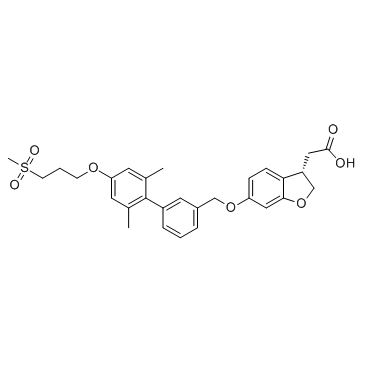| Description |
Fasiglifam (TAK-875) is a potent, selective and orally bioavailable GPR40 agonist with EC50 of 72 nM.
|
| Related Catalog |
|
| Target |
EC50: 72 nM (GPR40)
|
| In Vitro |
Fasiglifam (TAK-875) (0.01-10 μM) produces a concentration-dependent increase in intracellular IP production in CHO-hGPR40, with EC50 of 0.072 μM. Fasiglifam (TAK-875) (0.1-10 μM) dose-dependently augments intracellular IP production in CHO cells[1]. Fasiglifam (TAK-875) (3-30 μM) concentration-dependently augments [Ca2+]i. In the presence of 10 mM glucose, TAK-875 (0.001-10 μM) dose-dependently stimulats insulin secretion from INS-1 833/15 cells[2].
|
| In Vivo |
Fasiglifam (TAK-875) (10 mg/kg, p.o.) increases plasma insulin levels in ZDF rats. Fasiglifam (TAK-875) (30 mg/kg, p.o.) improves fasting hyperglycemia without affecting fasting normoglycemia. Fasiglifam (TAK-875) at 30 mg/kg, which is a 3- to 10-fold higher dose compared with the dose that improved glucose tolerance in diabetic rats, does not alter fasting glucose levels in SD rats with normal glucose homeostasis. Likewise, Fasiglifam (TAK-875) does not significantly alter insulin secretion in SD rats with normal fasting glucose levels [1].
|
| Cell Assay |
INS-1 832/13 cells are suspended in RPMI medium and seeded in a 96-well plate at a density of 2×104 cells/well; 1% BSA and 0.1% DMSO alone (control), palmitic acid (10, 100, and 1000 μM), oleic acid (10, 100, and 1000 μM), or Fasiglifam (TAK-875: 1, 10, and 100 μM) is added to the plate. After 72-h culture, medium is discarded, and cells are preincubated for 2 h with KRBH containing 1 mM glucose and 0.2% BSA at 37°C. After discarding of the preincubation buffer, KRBH containing 1 or 20 mM glucose and 0.2% BSA is added, and the plate is further incubated for 2 h. The insulin concentration in the supernatant is measured as described above. To measure intracellular insulin content, INS-1 832/13 cells are exposed to 1% BSA and 0.1% DMSO alone (control), palmitic acid (1000 μM), oleic acid (1000 μM), or Fasiglifam (TAK-875) (100 μM) with 1% BSA and 0.1% DMSO. After incubation, cells are washed once with phosphate-buffered saline, and acid-ethanol solution is added to each well, followed by sonication on ice. Intracellular insulin is extracted by overnight incubation at −30°C, followed by separation of supernatant by centrifugation at 12,000 rpm×5 min at 4°C.
|
| Animal Admin |
At 18 weeks of age, the N-STZ-1.5 rats are fasted overnight and orally given vehicle (0.5% methylcellulose) or Fasiglifam (TAK-8751, 3, and 10 mg/kg). Sixty minutes later, all animals receive an oral glucose load (1 g/kg). Blood samples are collected from the tail vein before drug administration, before glucose load (time 0), and 10, 30, 60, and 120 min after the glucose load. Plasma glucose and insulin levels are measured with an AutoAnalyzer 7080 and radioimmunoassay, respectively. To see the effects of Fasiglifam (TAK-875) on fasting normoglycemia and hyperglycemia, SD rats (8 weeks old) or ZDF and ZL rats (12 weeks old) are fasted overnight and orally given vehicle (0.5% methylcellulose), Fasiglifam (TAK-875) (10 or 30 mg/kg), nateglinide (50 mg/kg), or glibenclamide (10 mg/kg). Blood samples are collected from the tail vein before drug administration (time 0) and 0.5, 1, 2, and 3 h (SD rats) and 0.5, 1, 2, 4, and 6 h (ZDF and ZL rats) after drug administration, and plasma glucose and insulin levels are measured as described above.
|
| References |
[1]. Tsujihata Y,et al. TAK-875, an orally available G protein-coupled receptor 40/free fatty acid receptor 1 agonist, enhances glucose-dependent insulin secretion and improves both postprandial and fasting hyperglycemia in type 2 diabetic rats.J Pharmacol Exp [2]. Yoshiyuki Tsujihata, et al. TAK-875, an Orally Available GPR40/FFA1 Agonist Enhances Glucose-Dependent Insulin Secretion and Improves Both Postprandial and Fasting Hyperglycemia in Type 2 Diabetic Rats. JPET July 13, 2011 [3]. Nagatake T, et al. 17,18-EpETE-GPR40 axis ameliorates contact hypersensitivity by inhibiting neutrophil mobility in mice and cynomolgus macaques. J Allergy Clin Immunol. 2017 Dec 26. pii: S0091-6749(17)32949-4. [4]. Urano Y, et al. Comparative hepatic transcriptome analyses revealed possible pathogenic mechanisms of fasiglifam (TAK-875)-induced acute liver injury in mice. Chem Biol Interact. 2018 Sep 20;296:185-197.
|
